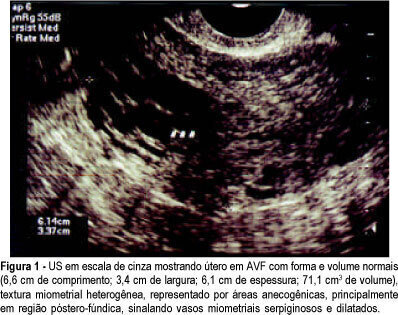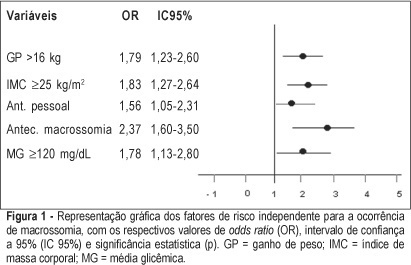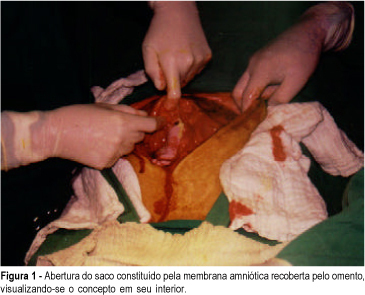Summary
Revista Brasileira de Ginecologia e Obstetrícia. 2006;28(2):112-121
DOI 10.1590/S0100-72032006000200007
PURPOSE: to investigate the presence and outcome of uterinevascular malformations (UVAM) after gestational trophoblastic disease (GTD). METHODS: retrospective study of 2764 patients with GTD diagnosed from 1987 to 2004. All patients were followed up annually at the "Santa Casa da Misericórdia" Trophoblastic Disease Center (Rio de Janeiro, RJ, Brazil) with transvaginal ultrasonography (US) and color Doppler imaging. Seven patients had a final diagnosis of UVAM based on ultrasonographic analysis - pulsatility index (PI), resistance index (RI), peak systolic velocity (PSV) - and pelvic magnetic nuclear resonance (MNR) findings. Negative beta-hCG values were of utmost importance to establish differential diagnosis with persistent GTD. RESULTS: the incidence of UVAM after GTD was 0.2% (7/2764). US features of UVAM: PI mean 0.44±0,058 (extremes: 0.38-0.52); RI mean 0.36±0.072 (extremes: 0.29-0.50); PSV mean 64.6±23.99 cm/s (extremes: 37-96). MNR image showed a bulky uterus, myometrial inhomogeneity, serpiginous flow-related signal voids, and prominent parametrial vessels. The most common UVAM clinical presentation was vaginal hemorrhage, present in 52.7% (4/7). Pharmacological management with 150 mg medroxyprogesterone acetate was employed to control bleeding, after hemodynamic stabilization. These patients are still being followed and remain asymptomatic nowadays. Two patients with persistent UVAM became pregnant and had successful outcomes. CONCLUSION: patients with antecedent of GTD presenting transvaginal bleeding and negative beta-hCG may be considered to have UVAM and should be investigated through US with Doppler velocimetry. Conservative management is a valuable option in many of the acquired UVAM after GTD.

Summary
Revista Brasileira de Ginecologia e Obstetrícia. 1999;21(5):297-298
DOI 10.1590/S0100-72031999000500009
Endometrial ablation is a useful technique in patientes with abnormal uterine bleeding without response to clinical measures. Pregnancy is possible even after the destruction or resection of the endometrium. The case reported is a normal term pregnancy after endometrial ablation because ot menorrhagia without successful prior clinical treatment.
Summary
Revista Brasileira de Ginecologia e Obstetrícia. 2006;28(1):10-17
DOI 10.1590/S0100-72032006000100003
PURPOSE: to describe to emotional process experienced with termination of pregnancy after the diagnosis of lethal fetal malformation. METHODS: thirty-five pregnant women who underwent termination of pregnancy for lethal fetal anomaly after judicial permission were interviewed. The most frequent fetal malformation was anencephaly (71.5%). The patients were submitted to an open interview as soon as the diagnosis of fetal malformation was confirmed, allowing them to express their feelings and stimulating them to think about asking for termination of pregnancy. The mean time spent until the judicial agreement was 16.6 days. The women who requested and were submitted to the procedure of abortion were invited to return for psychological evaluation after 30-60 days. At this moment, a semi-structured interview was performed to find the emotional aspects and feelings that existed. RESULTS: thirty-five patients were interviewed. The decision-making feelings about termination of pregnancy were negative for 60%, 51.4% declared that they had no doubts about the assumed decision and 65.7% declared that their own opinion was more important for decision than anyone else's. Most of the women (89%) affirmed to remember the facts about the procedure that they experienced, 91% affirmed that they would have the same attitude in the case of another similar situation in the future and 60% declared that they would advise someone to opt for termination of pregnancy if asked about the same situation. CONCLUSIONS: the anguish experienced showed that the process of thinking is very important for the decision-making process and posterior satisfaction with the assumed posture. The psychological follow-up allows to review the moral and cultural values in order to help the decision-making process with the aim of minimizing the suffering.
Summary
Revista Brasileira de Ginecologia e Obstetrícia. 2005;27(12):719-725
DOI 10.1590/S0100-72032005001200003
PURPOSE: to evaluate the prevalence, epidemiological profile (age and origin) and vertical transmission rate of HTLV I/II infection in pregnant women screened by the Pregnant Protection Program of the State of Mato Grosso do Sul Brazil. METHODS: it is a descriptive and transversal study of 32,512 pregnant women submitted to a prenatal screening from November 2002 to October 2003. HTLV I/II infection was diagnosed in all pregnant women by ELISA, confirmed by Western blot and PCR. Congenital HTLV infection was investigated by ELISA test, Western blot and PCR performed on the child's blood sample. The associations between data (age, origin and HTLV infection) were statistically analyzed by the chi2 test considering p<0.05 to reject the null hypothesis. RESULTS: a prevalence of 0.1% (37) 0.1% HTLV I/II among 32,512 pregnant women was found. The mean age of the infected women was 25.4 ± 6.4 years, and 78.4% of them were from other areas than the capital. There was no association between maternal age and the patients' origin and infection. In all the eight evaluated newborns, which represented 21.6% of the sample, HTLV I/II serum antibodies were found. Only one newborn infant was breast-fed. CONCLUSIONS : HTLV I/II prevalence among pregnant women of the State of Mato Grosso do Sul Brazil was lower than the rates reported by endemic HTLV countries. This rate was almost the same as that described for non-endemic areas and in some Brazilian reports. The vertical transmission rate of HTLV I/II was 100%, in spite of breast-feeding having been proscribed. Improving the follow-up of the pregnant women and their newborns in the State is mandatory, since only a few infants were investigated.
Summary
Revista Brasileira de Ginecologia e Obstetrícia. 2005;27(9):541-547
DOI 10.1590/S0100-72032005000900007
PURPOSE: to evaluate the predictors (clinical findings and physiological and anatomical scores) of the maternal and fetal outcomes among pregnant women victims of abdominal trauma who were submitted to laparotomy and to discuss particularities of assessment in this situation. METHODS: retrospective analysis of the medical records of 245 women with abdominal trauma and surgical treatment, from 1990 to 2002. Thirteen pregnant women with abdominal injury were identified. All cases were registered in the Epi-Info 6.04 protocol and data were analyzed statistically by the Fisher exact test, with confidence interval of 95%. RESULTS: ages ranged from 13 to 34 years (mean of 22.5). Six women (46.2%) were in the third trimester of pregnancy. Penetrating trauma accounted for 53.8% of injuries and in six of these patients the mechanism of trauma was gunshot wounds. Three patients had uterine injuries associated with fetal death. There were no maternal deaths and fetal mortality was 30.7%. The use of trauma scores was not associated with maternal and fetal mortality. Uterine injury was the only predictive risk factor for fetal loss (p=0.014). CONCLUSIONS: this is a retrospective study analyzing a small number of pregnant women victims of severe trauma. However, the results show that there are no predictive accuracy scores to evaluate maternal and fetal outcomes.

Summary
Revista Brasileira de Ginecologia e Obstetrícia. 2005;27(10):580-587
DOI 10.1590/S0100-72032005001000003
PURPOSE: to identify risk factors for fetal macrosomia in pregnant women with diabetes or daily hyperglycemia. METHODS: retrospective study, control-case, including 803 pairs of mothers and newborns belonging to this specific population, divided into two groups - macrosomic (cases, n=242) and non-macrosomic (controls, n=561). Variables regarding age, parity, weight and body mass index (BMI), weight gain (WG), diabetes history, high blood pressure and tabagism, diabetes type and classification, and glycemic control indicators in the third trimester were compared. The means were evaluated by the F test and the categorized variables were submitted to univariate analysis using the chi² test. The significative results were included in the multiple regression model for the identification of macrosomia independent risk considering OR, 95% CI and p value. The statistical significance limit of 5% was established for all analyses. RESULTS: there was a significative association between macrosomia and WG >16 kg, BMI >25 kg/m², personal, obstetric and macrosomic history, classification in the Rudge groups (IB and IIA + IIB), glycemic mean (GM) >120 mg/dL and postprandial glycemic mean >130 mg/dL in the third trimester. In the multiple regression analysis, WG >16 kg (OR=1,79; 95% CI: 1,23-1.60), BMI >25 kg/m² (OR=1.83; 95% CI: 1.27-2.64), personal history of diabetes (OR=1.56; 95% CI: 1.05-2.31) and of macrosomia (OR=2.37; 95% CI: 1.60-3.50) and GM >120 mg/dL in the third trimester (OR=1.78; 95% CI: 1.13-2.80) confirmed to be independent risk factors for macrosomia in these pregnancies. CONCLUSION: WG >16 kg, BMI >25 kg/m², GM >120 mg/dL in the third trimester and personal history of macrosomia and diabetes were identified as risk factors for fetal macrosomia in pregnant women with diabetes or daily hyperglycemia.

Summary
Revista Brasileira de Ginecologia e Obstetrícia. 1999;21(10):611-615
DOI 10.1590/S0100-72031999001000009
Term abdominal pregnancy with live fetus is an obstetrical rarity with high fetal and maternal morbidity and mortality. The authors present a case of abdominal pregnancy in a 43-year-old woman. The diagnosis was made only at term (37 weeks) by clinical findings and echography. Exploratory laparotomy was performed and a living female newborn weighing 2,570 g was extracted. Apgar scores were 3, 6 and 8 at the 1st, 5th and 10th minutes, respectively. Placenta was inserted in the omentum and was removed without complications. Postoperative course was uneventful and both mother and child were discharged healthy.
